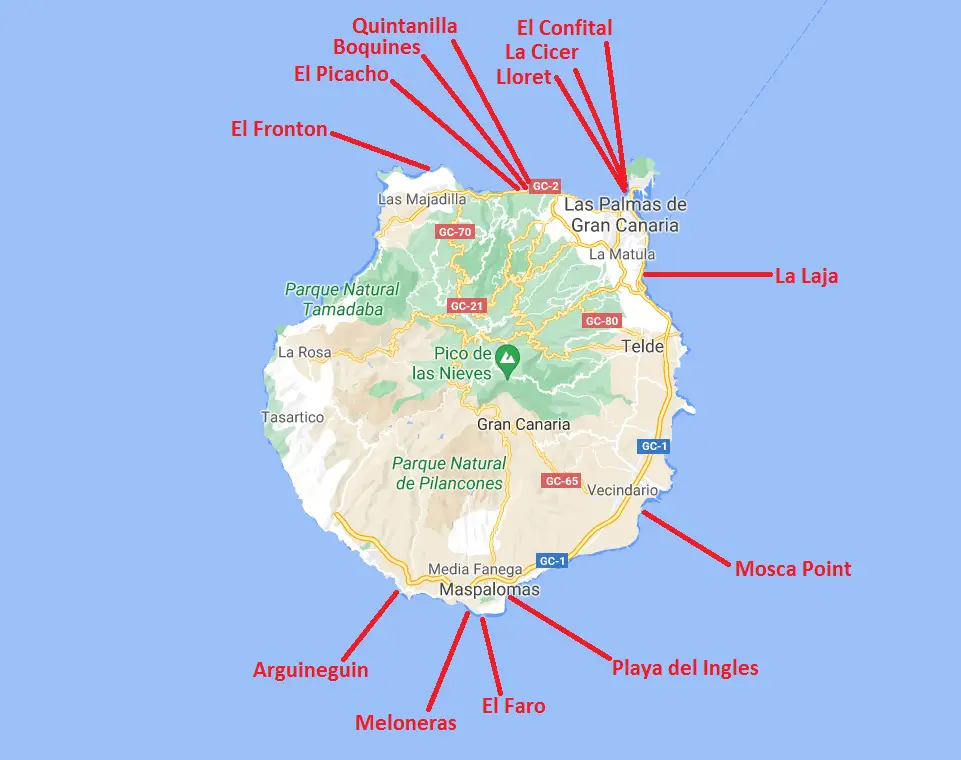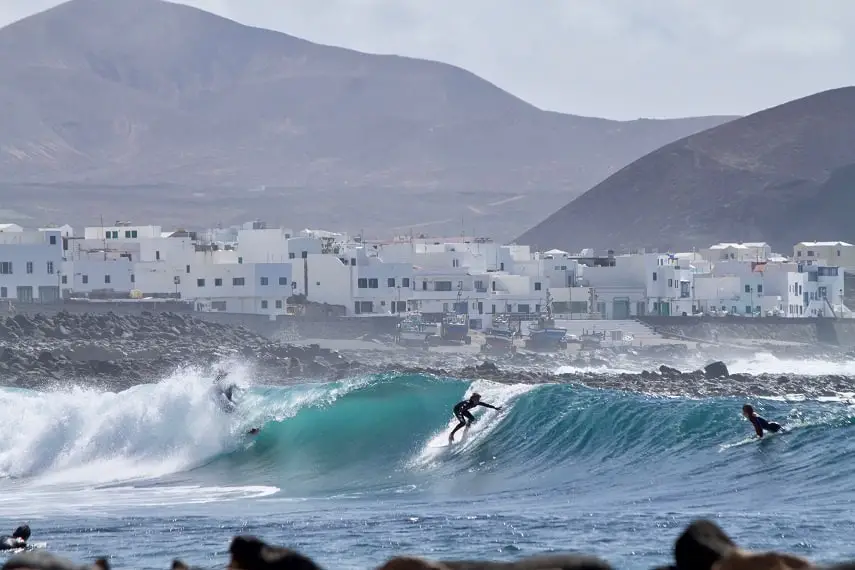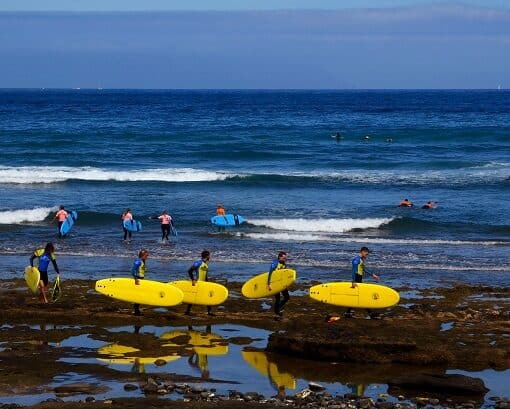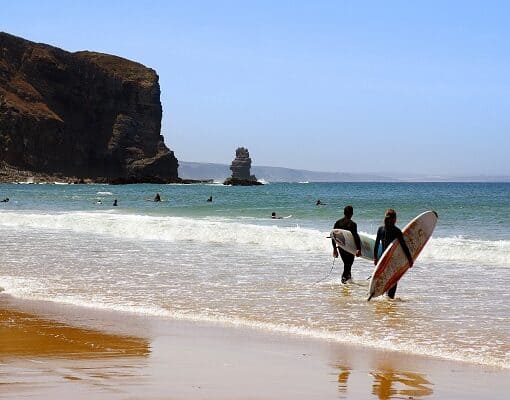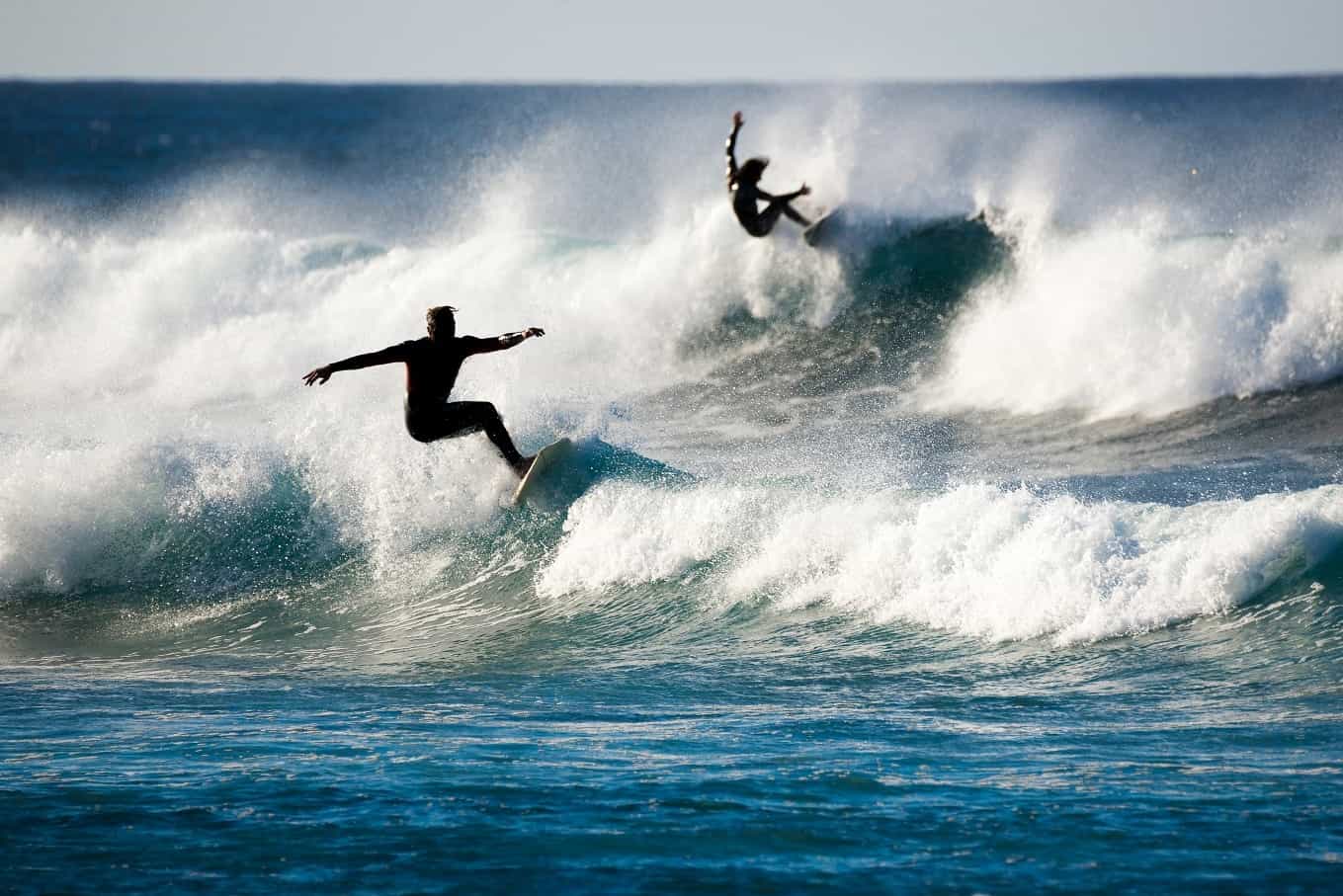Last updated on February 15th, 2024 at 08:23 pm
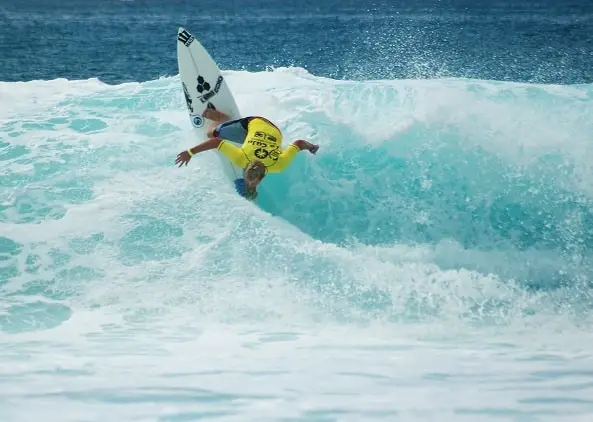
If you plan to surf in Gran Canaria, you came to the right place. In this surf guide, you will find all the information you need for your next surf trip, including surf seasons, surfer tips, and the best surf spots in Gran Canaria.
* Honest disclaimer- Reef Break is reader-supported. When you buy via links on our site, we may earn an affiliate commission at no cost to you.
Table of Contents
ToggleAbout Surfing in Gran Canaria
Gran Canaria is where perfect waves make their way to shore with great power and beautiful shape. This island offers year-round warm weather, consistent swells, and a vast variety of surf spots. Therefore, it is one of the best destinations you can choose for a surf trip.
Gran Canaria is located between Tenerife and Fuerteventura in the middle of the Canary Islands Archipelago. This round-shaped island is famous for its beautiful beaches and vibrant tourism scene. In fact, it receives an average of 2 million visitors a year, mainly from Europe. Even though it is considered a part of Spain, Gran Canaria is actually much closer to the Coast of Morocco and is exposed to the same swells.
As for the surf in Gran Canaria, it is absolutely wonderful. Due to the round shape of the island and the diversity of its coastline, consistent swells hit the shore almost every day of the year. Moreover, there are many surf spots in Gran Canaria of different types. While most of the waves break over a shallow volcanic reef, you can definitely find some good points and beach breaks, too. Therefore, the surf in Gran Canaria is suitable for any skill level. If you are an expert, you will find powerful barrels, especially on the North Shore. However, some beaches are more beginner-friendly, mainly on the South Shore, where you can find lots of surf schools and camps.
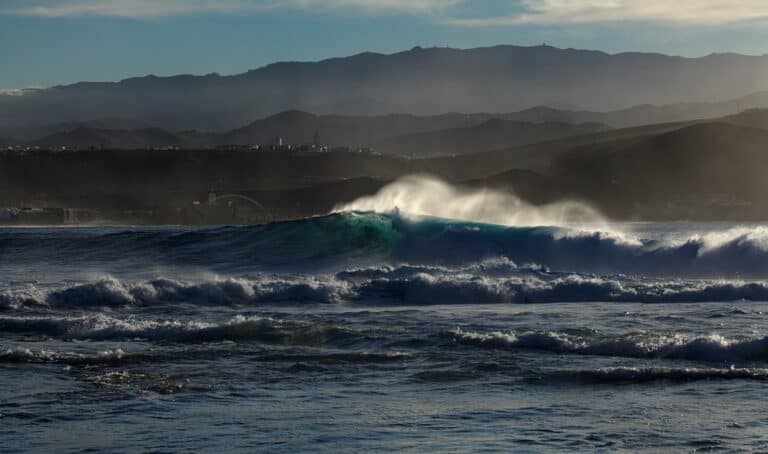
Surf Seasons in Gran Canaria
Just like in all the Canary Islands, you can surf in Gran Canaria all year. Since it is an Island, wherever the swell comes from, some surf beaches in Gran Canaria will receive it. Therefore, Gran Canaria is a very safe bet when choosing a destination for a surf trip.
During winter, which lasts from September to April, the north swells hit the island with massive power and excellent consistency. While the surf is up all season, the biggest swells come at the peak of it, between November and February. Since the waves can get huge during these months, this is the time for advanced surfers only to surf in Gran Canaria.
The summer months, between May and August, typically bring smaller swells. Therefore, if you are a beginner or an intermediate surfer, this is your recommended time to surf in Gran Canaria. The summer swells are not as predictable and not as consistent as in winter, but some of the beaches, especially the south-facing ones, actually work better during these months.
As for the water temperature, it ranges between 18°C (64°F) in winter and 24°C (75°F) in summer. Therefore, a 3/2 wetsuit is highly recommended during winter, while a short vest or spring suit should be enough during summer. Either way, booties are always recommended to protect your feet from reef cuts.Outside the water, the weather in Gran Canaria is always warm, so short sleeves and flip-flops are all you need.
Surf Spots in Gran Canaria
There are many different surf spots in Gran Canaria. You can divide the island into 2 different surf zones, the North and the South. The North Shore receives the powerful North Atlantic swells, especially during winter, and it is famous for its big and hollow waves. The South, on the other hand, is much more beginner-friendly. It is exposed to the south swells, which come during summertime, but a big north swell can also send some good waves in its direction.
In detail, these are the best surf spots in Gran Canaria:
Surf Spots in Gran Canaria’s North Shore:
El Confital:
This is the best right-hander in Gran Canaria and one of the best waves in Europe. It is long, steep, and hollow. Due to its high quality and easy access from the city of Las Palmas, it is crowded as hell.
La Cicer:
This is a great beach break for beginners. Therefore, many surf lessons take place here. During winter, spring, and fall, the waves here are very consistent.
Lloret:
This is another Canarian world-class break in the Las Palmas area. The waves in this spot break with perfect shape to the right side, and it is best during low tide. Just like El Confital, this spot is crowded and recommended for advanced surfers only.
La Laja:
This spot is situated on the northeast side of the island. During high tide, you can ride here a powerful left break over a shallow reef in the northern part of the beach. However, when the tide is low, the beach break in the middle of the beach is the one that produces better waves.
Quintanilla:
This left-hander breaks over a reef shelf about 100 meters offshore. In fact, the waves here are always bigger than anywhere else. Therefore, on the small days when other surf spots in Gran Canaria are flat, this is where you can get some decent size.
Boquines:
A right-hand point break with perfect shape and some barreling sections. Watch out for the strong riptides and the sea urchins on the reef.
El Picacho:
On the Western End of San Andres, this right-hand point break offers a long ride with great barrels, especially during low tide.
El Fronton:
A heavy, thick barrel over a very shallow reef. “The Beast”, as the locals call this wave, is a great challenge for bodyboarders and experts, but definitely not suitable for beginners.
Surf Spots in Gran Canaria’s South Shore:
Mosca Point:
This left-hand point break requires a big swell to work, but when such swell hits, you can get extremely long rides. Just be aware of the shallow reef at the end of the ride.
Playa del Ingles:
It is one of the most popular surf beaches in Gran Canaria among tourists. The waves here are soft and easy to ride and, therefore, perfect for beginners and intermediates.
El Faro:
This right-hand point break is excellent for intermediate surfers. Even though it breaks over a rocky bottom, it is relatively mellow and produces some beautiful long rides.
Meloneras:
A bit west of El Faro, this beach has several small peaks to choose from. This break is best for bodyboarders and requires a big swell to perform well.
Arguineguin:
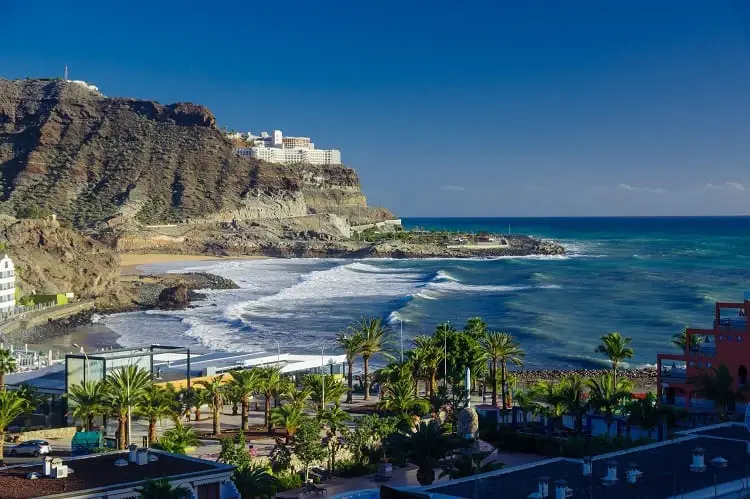
Can Beginners Surf in Gran Canaria?
Sure they can!
Although some of the surf spots in Gran Canaria are heavy, few of them are definitely suitable for beginners. For instance, beaches like Playa del Ingles and La Cicer offer mellow waves and a convenient environment to learn and practice. In short, surfers of all skill levels can surf in Gran Canaria.
Surf Camps in Gran Canaria
If you are a beginner making his first steps in the surfing world or even an intermediate seeking improvement, you can explore the surf beaches of Gran Canaria at a surf camp. These are the most recommended ones in town:
1. High Voltage surf adventure.
2. Ocean Side.
3. Atlantis Surf Camp.
4. Agüita Surf Hostel Gran Canaria.
5. Oceanside Gran Canaria Surf.
For more details about surf camps in Gran Canaria, please click here.
Surf Hotels in Gran Canaria
When going on a surf trip to Gran Canaria, you obviously want to stay as close as possible to the best surf spots on the island. So, these are some of the most recommended surf hotels to stay at:
1. Oasis Playa Maspalomas– Set 200 m from Maspalomas Beach, in the resort of Meloneras, Oasis Playa Maspalomas offers apartments with a private terrace. Featuring either sea or garden views, each apartment has a sofa and a TV with satellite and cable channels. There is a kitchenette with a toaster, microwave, and kitchenware. The bathroom features a shower.
2. La Ventana Azul Surf Hostel– Located in Las Palmas de Gran Canaria, La Ventana Azul Surf Hostel offers beachfront accommodation 50 m from Las Canteras Beach and provides various facilities, such as a shared lounge, a garden, and barbecue facilities. Among the facilities at this property are a shared kitchen and a business center, along with free WiFi throughout the property. The hostel features family rooms.
3. North shore holiday apartments shared roof terrace– Situated within 200 m of San Andrés Beach and 2.7 km of El Portillo Beach in Trapiche, North Shore holiday apartments shared roof terrace features accommodation with free WiFi.
For more surf hotels in Gran Canaria, check out the best deals on Booking.com.
Gran Canaria- Travel Information
Language– Spanish.
Population– about 900,000.
Currency– Euro.
Calling code– +34.
Time zone– GMT +1.
Pros– a wide selection of surf spots, great weather.
Cons– localism, sharp reef, cold water in winter.
Conclusion- A Final Few Words
To sum up, Gran Canaria is an outstanding surf destination. Here, you will find an impressive selection of surf breaks of all kinds and for any skill level. Moreover, if you have some extra time, you can check out the surf at the neighboring islands, such as Lanzarote. Either way, the Canary Islands will never disappoint you as a surfer.
We hope you liked this surf guide to Gran Canaria. Have a wonderful surf trip!
Author
-
Hi, my name is Matt. I am a surfer, a diver, a traveler, and a true ocean lover. After surfing in so many countries, I founded Reef Break to share my passion with other surfers and help them plan their surf trips better. If you have any questions or ideas to share, I would love to hear them, so please feel free to contact me at reefbreaksite@gmail.com.

